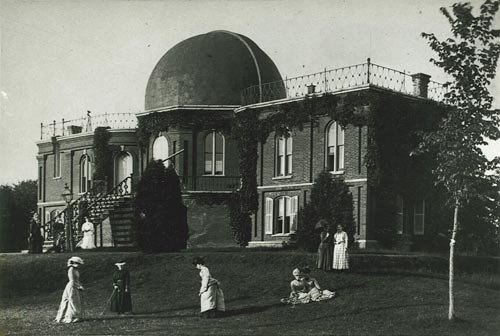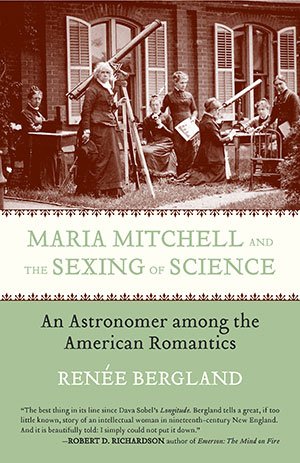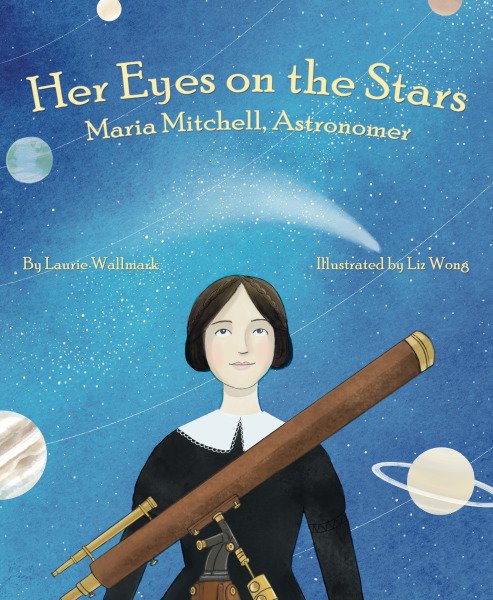MISS MITCHELL'S COMET
NANTUCKET, MA — The women were whalers’ wives, alone for months on end. It was said they wore ruts in floorboards, pacing and looking out to sea. Winters on the rocky island were frozen solid, as were souls after too much longing. But when clouds parted, the stars were as infinite as the sea.
On an October night in 1847, as darkness descended, one Nantucket woman excused herself from company. Donning her “regiments,” she walked down Main Street to the bank where her father worked. Climbing stairs she came to the telescope. Alone on the roof, she began to “sweep” the stars.
“One gets attached to certain midnight apparitions,” she wrote in her diary. “The Aurora Borealis is always a pleasant companion; a meteor seems to come like a messenger from departed spirits; and the blossoming of trees in the moonlight becomes a sight looked for with pleasure.”
Most nights her telescope took in just the usual miracle — worlds of light fixed in familiar patterns. But on this night a faint smudge stopped her in mid-sweep. Hurrying home, she told her father. It might be a comet.
Comets are chunks of ice and rock orbiting the sun. Some return on schedule. Others pass, wink, and are never seen again. The universe contains so many that few are named, the rest numbered. Today, C1847V1 is “Miss Mitchell’s Comet.”
Maria Mitchell lived in a time when women were ”accustomed to listen in silence.” But she was blessed with independence, curiosity, and parents who nurtured both. When she was seven, her father bought a telescope and the two spent nights calculating the clockwork of the heavens. By 12, Maria was charting eclipses. At 14, she was teaching sailors to use sextants.
In 1840, just a handful of colleges admitted women, so Maria became a librarian in the Nantucket Athenaeum. There she read Galileo and Copernicus and studied math. Then came the night of the comet, her comet if she could claim it.
Denmark’ Frederick VI had offered a medal to anyone discovering a “telescopic comet,” undetected by the naked eye. Maria had no interest in the medal, but her father alerted a friend in England. Too late. The Vatican astronomer had claimed the prize. But further letters followed, proving Maria’s earlier sighting. The medal arrived in Nantucket in 1849. Its gold face bore a quote from Virgil: “Not in vain do we watch the setting and rising.”
“Miss Mitchell’s Comet” made Maria famous. She toured Europe and America speaking about the stars. She might have taught astronomy, but America’s upstart women’s colleges did not consider women fit for science. Finally, in 1865, Maria Mitchell became America’ first female science professor.
At Vassar, Mitchell met “anxious mammas,” surrendering their girls into the college’s care. She welcomed the responsibility. She began each class by stating, “We are women studying together.” She gave no grades, saying “you cannot mark a human mind because there is no intellectual unit.” She spoke of finding “imagination in science.” The heavens were revealed by mathematics, but also contained “beauty and poetry.” Yet no one could take her classes without passing a rigorous math exam.
With her white ringlets and Victorian manner, Mitchell’s personality was, one student remembered, “so strong that it was felt all over the college.” She took students to study eclipses in Iowa and Colorado. Back at Vassar, they charted sunspots and the moons of Saturn. Her girls worshipped her, even as they wondered where in the rude world they might again study the stars.
“I have Miss Mitchell and all these grand instruments and no one here makes fun of it at all,” one wrote. “But when I go home no one there will take any interest in astronomy. Do you think I shall be brave enough then to hold on tight to what I have begun?”
Though Miss Mitchell lobbied tirelessly for women in science, she saw a broader purpose. “I cannot expect to make astronomers,” she told her girls, “but I do expect that you will invigorate your minds by the effort at healthy modes of thinking. When we are chafed and fretted by small cares, a look at the stars will show us the littleness of our own interests.”
Maria Mitchell died in 1888. Comet C1847V1 has not swept again past the earth. Its orbit, like its discoverer, was eccentric, bound for the stars.
Today, women earn a third of all degrees in astronomy, and the number is rising. Miss Mitchell’s foresaw this, too, in the moonlight. “Given one wide awake woman in the town,” she wrote, “You can rouse the whole.”












